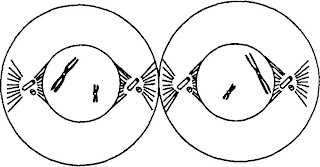Interphase
 Cell in normal non-dividing condition has chromosomes which are long and threadlike.
Cell in normal non-dividing condition has chromosomes which are long and threadlike.Early prophase I
 Chromosomes contract, becoming short and fat and visible. Nucleolus shrinks.
Chromosomes contract, becoming short and fat and visible. Nucleolus shrinks.Late prophase I
 Each chromosome seen to consist of a pair of chromatids. Pairing of homologous chromosomes occurs (synapsis)
Each chromosome seen to consist of a pair of chromatids. Pairing of homologous chromosomes occurs (synapsis)Metaphase I

Homologous chromosomes arrange themselves on equator of spindle
Anaphase I
 Homologous chromosomes separate from each other and migrate to opposite poles of the cell.
Homologous chromosomes separate from each other and migrate to opposite poles of the cell.Telophase I
 The chromosomes have reached their destination and the cell constricts across the middle as in mitosis. Nucleolus and nuclear membrane for each group of chromosomes reappears
The chromosomes have reached their destination and the cell constricts across the middle as in mitosis. Nucleolus and nuclear membrane for each group of chromosomes reappearsProphase II
 The two daughter cells prepare for the second meiotic division: centrioles have replicated and a new spindle is formed.
The two daughter cells prepare for the second meiotic division: centrioles have replicated and a new spindle is formed.Metaphase II
 Chromosomes arrange themselves at equator of the spindle.
Chromosomes arrange themselves at equator of the spindle.Anaphase II
 Chromatids separate at the centromere migrate to opposite poles of the cell.
Chromatids separate at the centromere migrate to opposite poles of the cell.Telophase II
 Cell constricts across the middle and nuclear membranes and nucleoli reformed as at the end of mitosis. Chromosomes appear as threadlike ion and the cells go into the resting stage (interphase).
Cell constricts across the middle and nuclear membranes and nucleoli reformed as at the end of mitosis. Chromosomes appear as threadlike ion and the cells go into the resting stage (interphase).
Comments